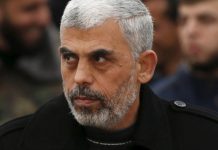
An Iranian missile apparently brought down a Ukrainian passenger jet, killing all 176 aboard, in what could be an “unintentional” firing, Canadian Prime Minister Justin Trudeau said Thursday, citing intelligence sources from Canada and allies.
Trudeau’s comments – as the nation mourned 63 Canadians on the flight and dozens others with links to the country – came after U.S. officials expressed “high confidence” that an Iranian antiaircraft missile brought down the Kyiv-bound Ukraine International Airlines flight on Wednesday near Tehran.
The officials, speaking on the condition of anonymity to discuss the matter publicly, said U.S. authorities believe the plane was hit by a SA-15 surface-to-air missile, a Russian-made system that is also known as a Tor air defense.
The officials offered no other details on the circumstances that led to the possible missile firing on Wednesday, which came about four hours after Iran launched ballistic missiles into Iraq against U.S. targets in retaliation for the killing of Iranian Maj. Gen. Qasem Soleimani.
Trudeau, speaking to reporters in Ottawa, said the missile-strike conclusion was based on “intelligence from multiple sources including our allies and our own intelligence.”
“The evidence indicates the plane was shot down by an Iranian surface to air missile. This may well have been unintentional,” he said, without giving further details.
President Donald Trump, speaking at the White House, said the passenger jet could have been downed by “mistake.”
“Well, I have my suspicions. I don’t want to say that, because other people have those suspicions also . . . Somebody could’ve made a mistake on the other side,” Trump said about the Ukrainian plane. “Some people say it was mechanical. Personally, I don’t think that’s even a question,” Trump told reporters.
European intelligence officials also believe the plane was shot down by mistake by Iran, according to a European official briefed on the matter.
The Tor system dates to the Cold War and can target planes, helicopters, drones or incoming missiles. Russia has exported the system to a number of countries, including Iran in 2005. It is designed to hit targets in the short-to-medium range.
Earlier, Ukrainian investigators said they were considering the possibility that an antiaircraft missile brought down the passenger jet; an initial Iranian report said the plane was on fire while still in the air and was turning back toward Tehran’s airport because of a “problem” when it went down.
A team of 45 experts and search-and-rescue personnel from Ukraine arrived in Tehran early Thursday to participate in the probe, as well as to identify and repatriate the bodies of the 11 Ukrainians aboard, including all nine crew members.
Before the U.S. and Canadian statements, Ukrainian investigators had said they were also looking into engine failure or a terrorist attack as possible causes of the crash. A Ukrainian intelligence official said investigators found no fire markings on the engines. The United States has not yet shared its assessment that an antiaircraft missile system probably brought down the plane, the Ukrainian intelligence source said, speaking on the condition of anonymity to discuss the investigation.
Oleksiy Danilov, secretary of Ukraine’s National Security and Defense Council, wrote on Facebook that his team wants to search for possible debris of the Tor air-defense missile, after seeing online reports about the discovery of possible fragments of one near the crash site.
Ukraine is familiar with the risks that antiaircraft weapons can pose to civilian aircraft in times of conflict.
In July 2014, Malaysia Airlines Flight 17 was downed by a missile shot from a Russian-made Buk surface-to-air system from rebel territory in Ukraine’s east. The attack on the Boeing 777, which was passing over the conflict zone while flying from Amsterdam to Kuala Lumpur, killed all 298 people aboard.
A joint investigative team from Australia, Belgium, Malaysia, the Netherlands and Ukraine identified a Russian military unit in charge of the antiaircraft missile system and has pursued prosecution of Russian and Ukrainian citizens allegedly involved. Russia has denied involvement in the incident.
Danilov said Ukraine’s investigative commission for the Tehran crash includes specialists who helped investigate the Malaysia Airlines Flight 17 crash site. The government in Kyiv has also suspended all Ukrainian flights over Iranian and Iraqi airspace.
Thomas Karako, who studies missile defense for the Center for Strategic and International Studies, said there is “going to be hell to pay” with Tehran’s standing in Europe if it is determined that Iran shot down the airliner.
“It’s really going to hurt their ability to manipulate the Europeans and other folks into believing that Iran is somehow the victim” after the U.S. drone strike that killed Soleimani.
The responsibility for air defense traditionally falls to Iran’s Air Defense Force command, said Saeid Golkar, a political science professor at the University of Tennessee at Chattanooga who has studied Iranian security forces for 20 years.
Orders to mobilize the country’s air defense are given by a central command center, which includes air-defense batteries controlled by Iran’s two armed forces: the regular military and the more elite Islamic Revolutionary Guard Corps. Within this system, the Revolutionary Guard is also in control of its own air-defense systems and has the capability of acting without authorization, Golkar said.
“It is possible that the IRGC acted alone?” Golkar asked.
“If you asked me if its possible if someone mistakenly shot it down, I’d say yes, because of the whole informality of the system,” Golkar said.
The Ukraine International Airlines flight departed Tehran at 6:12 a.m. Wednesday and was approaching 8,000 feet when it abruptly lost contact with ground control, officials said.
The report from Iran’s Civil Aviation Organization said witnesses – on the ground and among the crew of another flight in the vicinity – reported seeing a fire while the Boeing 737-800 was still in the air, followed by an explosion when it slammed into a field near an amusement park.
A video from a closed-circuit television camera posted on Twitter by Iran’s state broadcaster showed the predawn darkness suddenly lit in a fiery orange glow and then flaming debris scattering over a wide area.
“The trajectory of the collision indicated that the plane was initially moving toward the west, but after encountering a problem, it turned to the right and was approaching the airport again at the time of the crash,” Ali Abedzadeh, head of the Civil Aviation Organization, said in the report.
Iranian officials said immediately after the crash that the plane had encountered technical problems, but that did not appear in the report, which also noted that there was no distress call from the aircraft.
The passengers on the plane were mostly Iranians and included Europeans and more than 60 Canadian citizens.
The Iranian report said the flight data recorder and cockpit voice recorder were recovered but were damaged. Abedzadeh has said Iran will not share those “black boxes” with Boeing, but other countries, including the United States, have been invited to participate in the investigation in accordance with international guidelines.
John Cox, a leading airline safety consultant and former pilot, said Iranian officials have indicated that they will conduct their probe in accordance with the International Civil Aviation Organization, which outlines the process by which international crashes are investigated. Under its standards, the United States has a right to participate in the probe because the jet was built and certified in the country.
The National Transportation Safety Board on Thursday declined to say whether it will participate in the investigation. However, two sources with knowledge of the investigation but not authorized to speak publicly said the safety body has been asked by the ICAO to take part in the probe.
Still, U.S. sanctions against Iran, which include limits on travel and information sharing, will complicate any U.S. involvement.
NTSB officials would have to seek a license from the Office of Foreign Assets Control to travel to Iran, a process that can take months or years, experts say. And even if they secure a license, U.S. officials may be limited in what information they can share with Iranian officials.
On Wednesday, Brig. Gen. Abolfazl Shekarchi, a spokesman for the Iranian armed forces, described mounting speculation that the plane was shot down by a missile as American “psychological warfare,” as well as “ridiculous” and an “utter lie,” according to Iran’s Mehr news agency
“Most of the passengers on this plane were invaluable Iranian youth,” Shekarchi said. “Everything we do is aimed at defending our people’s and country’s security.”
(c) 2020, The Washington Post · Isabelle Khurshudyan, Missy Ryan, Dan Lamothe, Paul Sonne
{Matzav.com}












totally, the AA weapon just pulled it’s own trigger. of course, why didn’t we think of that one after the USS Vincennes incident…..
Had they not denied it at first claiming that it was engine failure, you can say “possible ‘unintentional’ firing”. However, since they denied it and only later thought of saying it was unintentional, there must have been reason for their firing the missiles. WILL THE US INTEL DISCLOSE WHOM THEY NEEDED TO GET RID OF?
The same cowardly Canadians who are scared to say the truth about the missiles intentional hitting the plane is threatening journalists with arrest for calling Soleimani a “Terrorist”.